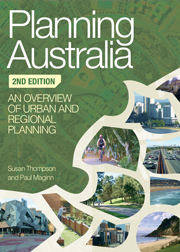Book contents
- Frontmatter
- Contents
- Contributors
- Figures and tables
- Discussion points and case studies
- Preface
- Acknowledgments
- Abbreviations
- Table of statutes
- Introduction
- Part I Frameworks
- Part II Key Issues
- 6 Planning and the natural environment
- 7 The metropolis
- 8 Planning for rural landscapes
- 9 Planning for regions
- 10 Planning for diverse communities
- 11 Aboriginal and Torres Strait Islander Australians
- 12 Community participation in planning
- 13 Urban design
- 14 Planning for heritage conservation and management
- 15 Transport planning
- 16 Healthy planning
- Conclusion: planning Australia into the future
- Index
- References
Conclusion: planning Australia into the future
from Part II - Key Issues
- Frontmatter
- Contents
- Contributors
- Figures and tables
- Discussion points and case studies
- Preface
- Acknowledgments
- Abbreviations
- Table of statutes
- Introduction
- Part I Frameworks
- Part II Key Issues
- 6 Planning and the natural environment
- 7 The metropolis
- 8 Planning for rural landscapes
- 9 Planning for regions
- 10 Planning for diverse communities
- 11 Aboriginal and Torres Strait Islander Australians
- 12 Community participation in planning
- 13 Urban design
- 14 Planning for heritage conservation and management
- 15 Transport planning
- 16 Healthy planning
- Conclusion: planning Australia into the future
- Index
- References
Summary
Key terms: contemporary planning practice; local communities; diversity; governance; globalisation; environmental sustainability; climate change; regulation; cultural landscape; neo-liberalism; ethics.
Planning Australia has brought together the themes at the forefront of planning in Australia today. In its attempt to be comprehensive, the book has touched on the broad range of issues that constitute contemporary planning practice and scholarship. We have aimed to give the reader, whether new to planning or keen to know more, as complete a picture as possible of the discipline’s foundational principles and historical evolution, its prime concerns, its current challenges and its future possibilities. This conclusion draws matters to a close by reflecting on the themes canvassed across the different chapters and imagining how planning in Australia can be a positive force, playing its part in enabling a sustainable future for the environment and the diverse communities who inhabit the vast expanse of this nation.
Planning Australia today: the issues
Although the authors in Planning Australia have addressed many diverse issues, it is possible to identify several unifying themes throughout the book. History shows us that most are not new to planning; rather, they take on a different intensity and emphasis in today’s world. Perhaps the biggest shift lies in the pace of change and our awareness of the complex and interdependent nature of the challenges that confront humankind today.
- Type
- Chapter
- Information
- Planning AustraliaAn Overview of Urban and Regional Planning, pp. 409 - 418Publisher: Cambridge University PressPrint publication year: 2012

